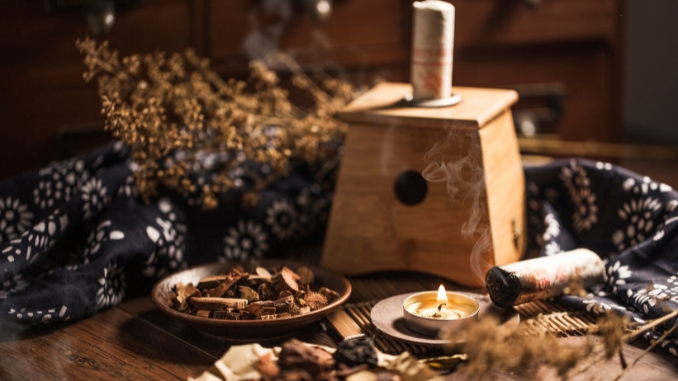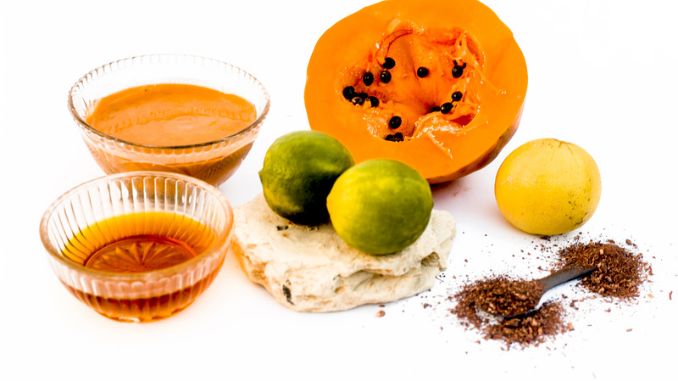In a world where stressors are everywhere and when modern medicine falls short, ancient healing practices are gaining renewed attention. Among these time-honored techniques is moxibustion, an integral component of traditional Chinese medicine (TCM).
It has been used for centuries to promote wellness and treat various ailments as an alternative medicine. This article explores the power of moxibustion and how it can be harnessed to improve overall well-being in today’s fast-paced lifestyle.
What is Moxibustion?
Moxibustion is derived from the Chinese term “zhenjiu,” meaning acupuncture and moxibustion [1]. It is a therapeutic practice that involves the burning of mugwort, a dried herb, on specific points of the body to stimulate energy flow and restore balance.
This therapy is based on TCM principles, which view health as the harmonious flow of qi (life force) through meridian pathways. Moxas, the main ingredient for moxibustion practices, have changed over time, ranging from the raw ingredients of moxa to pure processed ones, and lastly, the smokeless variety. These three have distinct effects that give them an advantage over the other.
1. Raw Moxa

Raw moxas are the ingredients for this practice. When burned, moxa provides a calming, aromatic odor that helps cure colds. It warms the meridians and expels colds, promoting better blood and energy circulation.
These are not meant to be burned separately but processed into pure moxa sticks It can also be plucked and applied to small, direct moxa cones, also known as scarring moxibustion, to help apply this techniques.
2. Pure Processed Moxa
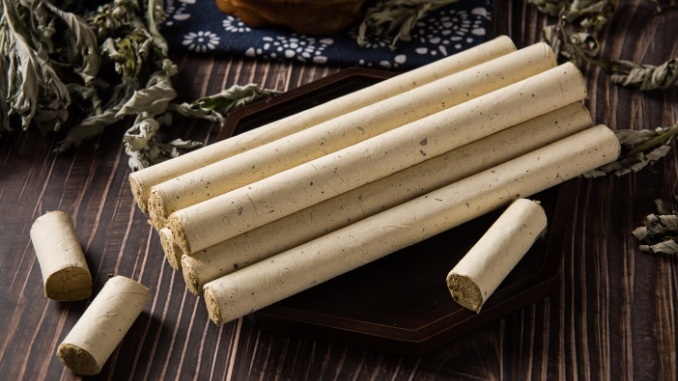
After processing, moxa can be shaped into different forms, including loose wooly material, cones, sticks, or compressed into cigar-like cylinders. The choice of form depends on the intended moxibustion technique and the specific therapeutic goals.
This one is the most widely used form of moxa for moxibustion therapy[2]. It has the strongest aroma of the other choices, so many prefer it as the ideal moxa for its quality and portability. You can always burn it on the go.
3. Smokeless Moxa
It is nearly identical to the pure processed one, from its cones, sticks, or cigar-like cylinders forms to how it is processed. However, unlike traditional moxibustion, this bellows less smoke and is less aromatic than its counterpart.
Some people prefer this to pure processed ones because it is less aromatic and produces less smoke. It is also popular for some working in an office as its aroma and smoke are less noticeable to others.
The History of Moxibustion

This Chinese medicine practice can be traced back thousands of years to ancient China. It is believed to have originated during the Zhou dynasty and was further developed and refined in subsequent eras.
The earliest written records about moxibustion are in the Huangdi Neijing (Yellow Emperor’s Inner Canon), one of TCM’s foundational texts. It was traditionally used to treat various illnesses and promote general well-being.
It was believed that the burning of mugwort on specific points of the body could stimulate the flow of qi, remove blockages, and restore balance to the body’s systems.
Over time, moxibustion became an integral part of TCM and continues to be practiced and respected today, with studies and groups supporting the effects of TCM.
Studies such as The Mechanisms of Moxibustion: An Ancient Theory and Modern Research and the Journal of Acupuncture and Meridian Studies are prime examples.
How Does Moxobustion Work?
Moxibustion works by applying heat to specific points on the body. This heat is believed to stimulate the flow of qi, promote blood circulation, and activate the body’s natural healing mechanisms.
The burning mugwort produces a penetrating heat that reaches deep into the body, providing a therapeutic effect. There are various techniques used in moxibustion, including direct and indirect methods.
In direct moxibustion, a small cone or moxa stick is placed directly on the skin and burned until it generates heat while in indirect moxibustion, the moxa is burned at a distance from the skin, either on top of an acupuncture needle or on a slice of ginger or garlic.
Both methods have advantages and are chosen based on the individual’s condition and practitioner’s expertise.
Different Types of Moxibustion Technique
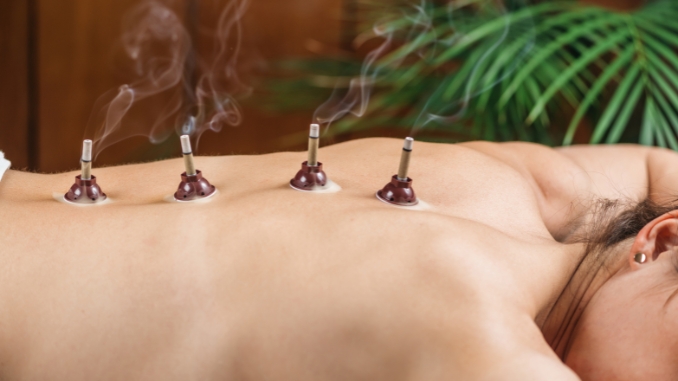
1. Direct Moxibustion
A small cone or stick of moxa is placed directly on the skin and burned until it generates heat.
This technique does not need acupuncture needles and allows for more precise and localized heat therapy treatment. The distance between the moxa and the skin and the duration of the burning can adjust the intensity of the heat.
2. Indirect Moxibustion
Involves using a medium, such as ginger, garlic, or salt, to separate the moxa from the skin[3].
The moxa is burned on top of the medium, transferring the heat to the acupuncture point without directly contacting the skin. This method is often used for patients with sensitive skin or in areas where direct application may not be suitable.
3. Warm Needle Moxibustion
Warm needle moxibustion combines acupuncture and moxibustion techniques. A small moxa cone is placed on top of an acupuncture needle inserted into an acupuncture point.
The moxa is ignited, generating heat penetrating the skin and stimulating the acupuncture point. This technique is commonly used for conditions such as pain, muscle tension, abdominal pain, gastrointestinal issues, and breech presentation experienced by pregnant women.
Moreover, warm needle moxibustion combines acupuncture and moxibustion by placing a moxa cone on an acupuncture needle. Overall, warm-needle, direct, and indirect moxibustion provide practitioners with versatile options for addressing various health conditions. This makes moxibustion a valuable therapy in holistic healthcare practices.
The Health Benefits of Moxibustion
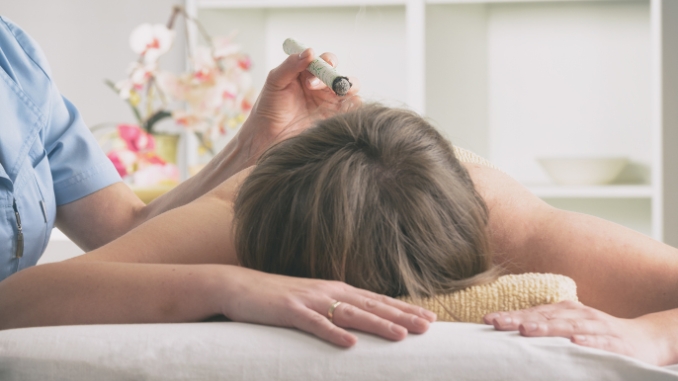
Moxibustion has been used for centuries to treat various health conditions and promote overall well-being. Scientific research and anecdotal evidence have shown that it helps in alleviating pain. Along with reducing inflammation, boosting the immune system, improving digestion, and supporting mental health.
Let’s explore some of the specific health benefits of moxibustion.
1. Pain Relief and Musculoskeletal Conditions
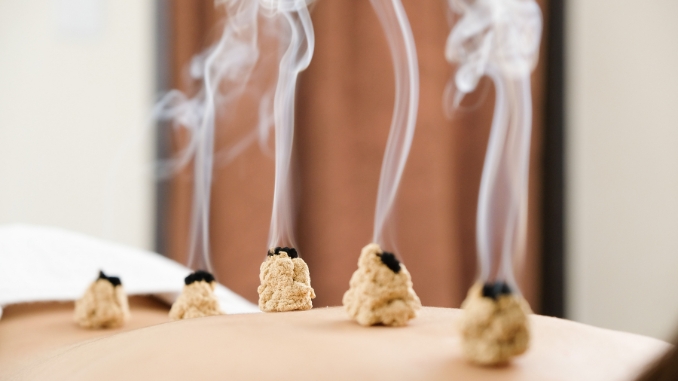
One of the most well-known applications of moxibustion is its ability to alleviate pain. Whether it’s chronic pain, acute injuries, or musculoskeletal conditions, moxibustion effectively reduces pain and promotes healing.
The heat generated by moxibustion helps increase blood circulation, relax muscles, and release tension, relieving discomfort. Studies have shown that this can be beneficial for conditions such as arthritis, back pain, migraines, and sports injuries.
In addition, it can help improve or manage joint mobility and flexibility. Overall, it offers a natural and non-invasive alternative to pain medication and other conventional treatments.
2. Digestive Disorders and Immune Support
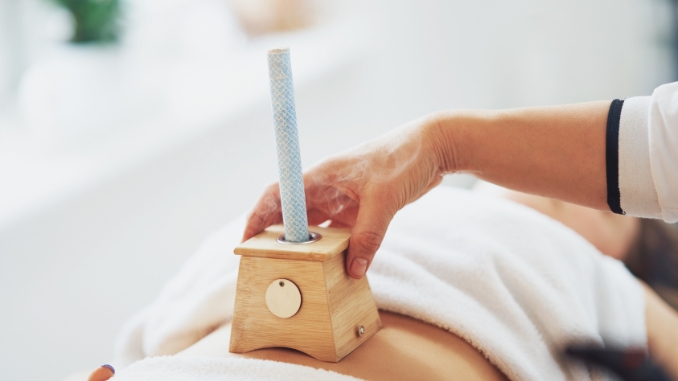
Digestive disorders such as irritable bowel syndrome (IBS), indigestion, and bloating can significantly impact a person’s quality of life. Moxibustion effectively promotes healthy digestion and alleviates symptoms related to digestive disorders.
By stimulating specific points, moxibustion helps to regulate the digestive system, improve nutrient absorption, and reduce inflammation in the gut. Furthermore, moxibustion has immune-boosting properties.
Furthermore, it can enhance the body’s natural defense mechanisms and strengthen the immune system, making it more resilient to infections and illnesses. Improving overall immune function, moxibustion can help prevent recurrent infections and enhance overall well-being.
3. Fertility and Women’s Health
Moxibustion has long been used to support women’s health and fertility. It can be beneficial for conditions such as menstrual irregularities, fertility issues, and menopausal symptoms.
By stimulating specific acupuncture points, it helps regulate hormonal balance, improve blood circulation to the reproductive organs, and promote overall health. Research has shown that moxibustion can increase the success rate of in vitro fertilization (IVF) and improve pregnancy outcomes.
It can also help alleviate symptoms associated with menopause, such as hot flashes, night sweats, and mood swings. It offers a natural and holistic approach to women’s health, supporting the body’s innate healing abilities.
Safety Precautions and Considerations

While moxibustion is generally safe when performed by a trained practitioner, there are certain precautions and considerations to remember. Moxibustion should be avoided or used with caution in certain situations.
Events such as during pregnancy, in cases of open wounds or infections, and for individuals with certain medical conditions. It is essential to consult with a qualified healthcare professional or licensed acupuncturist before undergoing moxibustion.
They will assess your health needs and determine the most appropriate treatment plan. It is crucial to receive this from a reputable practitioner who has received proper training and follows strict hygiene protocols.
Disadvantages of Moxibustion
1. Risk of Burns
Moxibustion involves applying heat to specific points on the body using burning moxa. If the moxa is placed too close to the skin or left on for too long, it can cause burns. This risk requires careful attention and skill from the practitioner to prevent injury.
2. Smoke Inhalation
The burning moxa produces smoke, which can be inhaled by both the patient and the practitioner. For individuals with respiratory issues such as asthma or chronic obstructive pulmonary disease (COPD), this smoke can exacerbate symptoms, leading to discomfort or respiratory distress.
3. Odor
The process of burning moxa generates a distinctive and often strong odor. Some people may find this smell unpleasant or overwhelming, which can be a deterrent to using moxibustion. The odor can also linger on clothing and in the treatment area.
4. Skin Irritation
The heat and the substances released from burning moxa can cause skin irritation or allergic reactions in some individuals. This may manifest as redness, itching, or a rash at the site of application, necessitating careful monitoring and sometimes discontinuation of the treatment.
5. Scarring
In direct moxibustion, where moxa is placed directly on the skin and allowed to burn until it extinguishes, there is a risk of leaving scars. These small, circular scars can be permanent and may be cosmetically concerning for some individuals. Proper technique and cautious application are also essential to minimize this risk.
Limitations of Moxibustion
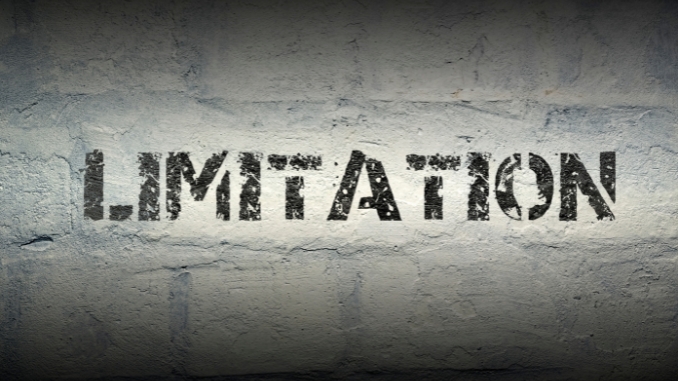
- Lack of Standardization – This practices can vary widely in technique, materials, and application methods. This variability can also lead to inconsistent treatment outcomes, making it challenging to establish uniform guidelines for its use. Without standardization, it is difficult to compare results across different studies and practitioners.
- Limited Scientific Evidence – While there is some evidence suggesting the benefits of moxibustion, comprehensive and high-quality clinical trials are still lacking. The limited scientific data makes it hard to conclusively determine its effectiveness for various conditions. This gap in evidence can also hinder its acceptance in mainstream medical practice.
- Requires Skilled Practitioner – Effective and safe moxibustion requires a practitioner with proper training and experience. An unskilled practitioner might apply incorrect techniques, potentially leading to burns or ineffective treatment. Finding a qualified practitioner can be challenging, especially in regions where moxibustion is not widely practiced.
- Cultural Acceptance – It is deeply rooted in traditional Chinese medicine and is more commonly accepted in East Asian cultures. However, people may be less familiar with the practice in other parts of the world, leading to skepticism or reluctance to try it. This cultural barrier can limit its use and acceptance in diverse populations.
- Time Consuming – Moxibustion sessions can be lengthy, requiring the patient to remain still for extended periods. This can be inconvenient for individuals with busy schedules or those who find it difficult to commit to regular sessions. The time investment required might deter some people from continuing with the treatment.
Moxibustion is deeply rooted in traditional Chinese medicine and is more commonly accepted in East Asian cultures. However, people may be less familiar with the practice in other parts of the world, leading to skepticism or reluctance to try it. This cultural barrier can limit its use and acceptance in diverse populations.
Contraindications of Moxibustion

- Pregnancy – Moxibustion is generally avoided during pregnancy, particularly in certain points and stages, as it can potentially stimulate uterine contractions and pose a risk to the fetus. Practitioners need to be cautious and knowledgeable about which points are safe to use, if any, during pregnancy.
- Febrile Conditions – Individuals with high fever or febrile conditions should avoid moxibustion because the additional heat from the treatment can exacerbate the fever and worsen the patient’s overall condition. Cooling therapies are also more appropriate in these cases.
- Infectious Skin Conditions – It should not be performed on areas with active skin infections, open wounds, or sores. Applying heat to these areas can aggravate the infection and impede healing, potentially leading to further complications.
- Diabetes – Patients with diabetes, especially those with peripheral neuropathy, may have reduced sensitivity to heat and pain. This can increase the risk of burns and skin damage since they may not feel the heat intensity properly. Careful monitoring and adjustments are also necessary if moxibustion is to be used.
- Neurological Conditions – Individuals with conditions that affect their sensation or ability to communicate discomfort should avoid moxibustion.
- Allergies to Smoke – Those with allergies or severe sensitivities to smoke should avoid this to prevent respiratory distress.
- Cancer – Moxibustion should be avoided over tumor sites or in individuals undergoing certain cancer treatments, as it may interfere with their condition.
These points highlight the critical aspects to consider when evaluating moxibustion as a therapeutic option.
Conclusion
Incorporating moxibustion into your wellness routine offers a holistic approach to wellness and healing. By harnessing the power of heat and stimulating specific acupuncture points, it can promote balance, alleviate pain, support digestion, and boost the immune system.
If you are interested in exploring the benefits of moxibustion, it is important to seek guidance from a qualified moxibustion practitioner. They can assess your individual needs, provide personalized treatment, and also ensure your safety throughout the process.
This can be a valuable addition to your wellness routine. But also be aware of the risks of using it. It can range from mild burns and skin irritation to skin and other neurological conditions.
Regardless, moxibustion complements other holistic practices such as acupuncture, herbal medicine, and lifestyle modifications. Unlock the power of Chinese medicine moxibustion and discover the ancient wisdom that can support your well-being in today’s modern world.
Embrace the harmonious flow of energy and restore balance to your body, mind, and spirit with this time-honored therapy. Experience the transformative effects of moxibustion and embark on a journey of healing and self-discovery.
From now on, you no longer have to live with the dire consequences of poor digestion. You can finally obtain “gut health security” and enjoy your favorite foods, symptom-free all day long! Check out this 14-Day Digestive Health Quick Start Program!


Rick Kaselj MS, is a leading kinesiologist and injury specialist as well as co-creator of the best-selling Unlock Your Hip Flexors program. Rick creates exercise programs that help people heal injuries and eliminate pain, so they can go back to living a full, active, healthy life.

